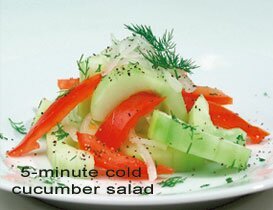healthy food tip and recipe
Today's Recipe
If you don't know what to serve for dinner tonight ...
Stay cool with this easy-to-prepare salad as the weather begins to warm as summer approaches.

Ingredients:
- 1/2 medium red onion, sliced thin
- 1 medium clove garlic, chopped
- 1 medium cucumber, halved, seeds removed, and sliced
- 1 medium tomato, cubed
- 1 medium red bell pepper, diced
- 1 TBS feta cheese
- 6 kalamata olives, cut into halves or quarters
- 2 TBS fresh lemon juice
- Sea salt and pepper to taste
- Fresh or dried dill (optional)
- Chop garlic and slice onions and let sit for 5 minutes to bring out their health-promoting properties.
- Combine all ingredients and serve.
In-Depth Nutritional Profile for 5-Minute Cold Cucumber Salad
Healthy Food Tip
Why is range-fed and grass-fed meat and poultry better?
The natural behavior of cows, chickens turkeys, pigs, and other animals commonly eaten for food in the United States is to live outdoors and to consume food that is part of the natural habitat. For example, in the case of ruminant animals like cows, there is a long history of development in which the digestive system of the cow has adapted to foraging and consumption of plants often referred to as "forages." These plants include many grasses and legumes.
When cows are fed in a non-natural way, digestive tract problems can develop, and medications may be needed to offset problems caused by the cows' non-natural diet. For example, when being raised to provide non-organic beef, it is not unusual for a cow to be fed more than 10 pounds of corn per day. Since the cow's digestive system is poorly matched to this large volume of grain in the daily diet, it is placed at risk for certain problems including bursting of the stomach from excessive amounts of gas that can be produced by fermentation of grain. In the case of non-organic beef, medications that prevent gas formation (like poloxalene) may be given to cows on a preventive basis as part of their standard diet to prevent this gas formation. However, the routine administration of a medication like poloxalene cannot be carried out in the raising of certified organic beef. Research studies have made it clear that cows remain healthier when they are fed and raised in a natural wa y. Healthier cows also mean healthier meat for all individuals who include meat in their diet.
One great benefit of grass feeding is the increased presence of omega-3 fatty acids in beef provided by grass-fed cattle. I've seen two studies on Australian beef that clearly document this trend, which stems from the natural presence of alpha-linolenic acid (also known as ALA, the omega-3 fatty acid that serves as the building block for all other omega-3 fats) in pasture grasses and legumes. While more complicated omega-3 fats like EPA (eicosapentaenoic acid) and DHA (docosahexaenoic acid) are not present in pasture crops, these critical omega-3 fats are produced in the cow's body from the ALA present in the pasture plants and you can receive substantial amounts of EPA and DHA from pasture-fed beef along with its ALA. These amounts are still very low, however, in comparison with the far greater amount of EPA and DHA provided by an equivalent amount of an omega-3-containing fish like salmon. The amount of ALA in grass-fed beef is also very much lower than the amount of ALA provided by plant foods like flaxseeds and walnuts, which are rich in this omega-3 fatty acid.
I want to point out that the purchase of certified organic beef, poultry, and other meats does not guarantee range-feeding. Unfortunately, the livestock living conditions spelled out in the National Organics Program only includes "access to the outdoors" and "access to pasture" and does not specify any required period of time for natural outdoor living. Nor does it require any amount of foraging crops in the diet. For this reason, you'll need to look for the terms "range-fed" or "grass-fed" on the label in addition to the organic certification. Organic meat that is not labeled either "range-fed" or "grass-fed" is still a very good option for you in the market, but if organic combined with range-fed or grass-fed is available, I encourage you to consider that combination as your best opt ion.

No comments:
Post a Comment